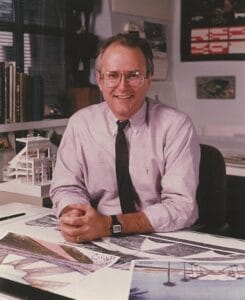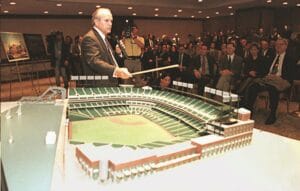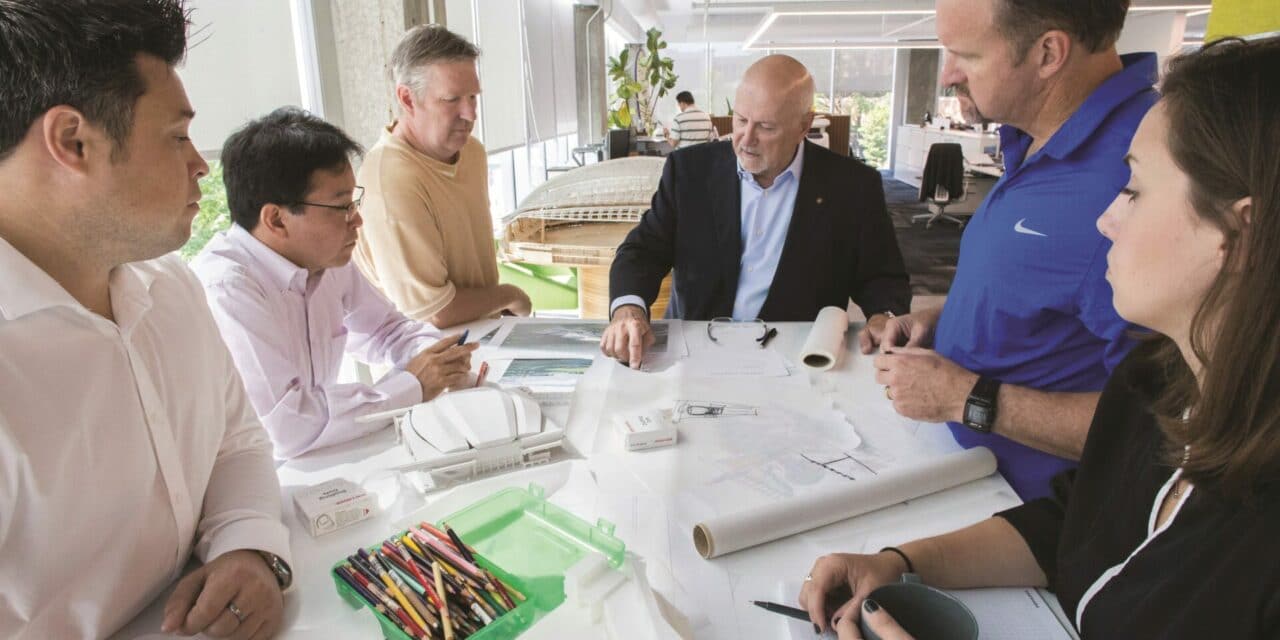To The Drawing Board: Joe Spear, pictured center, was part of the original HOK Sport, which evolved into Populous in 2009. Photo courtesy Populous.
Joe Spear
Connecting Cities with Sports Architecture
Sports designer Joe Spear learned a valuable lesson in Buffalo in 1988. It turned into a master class, taught by Spear, showing how stadium architecture dives far deeper than the number of restrooms and sightline angles.
It was in Buffalo where Spear, co-founder and senior principal with Populous, first understood the value of relationships between the architect and project owner and extending to the city itself. It’s a mantra he’s carried now for over five decades designing some of the most recognizable sports venues across the country.
“A stadium needs to be something that people fall in love with,” Spear said. “That is a very different set of criteria in, say, Cleveland, San Francisco, San Diego or Baltimore. It is not formulaic. If we do our job well, the fans will fall in love with the place and because they cherish it, it will be well maintained and well cared for.”
Spear was part of the original HOK Sport which launched in 1983 and evolved into Populous in 2009 after a group of designers broke off from HOK corporate. Regardless of the brand, Spear’s name is synonymous with baseball design.
See: VenuesNow 2021 Hall Of Honor

Oriole Park at Camden Yards. Photo by: Jerry Driendl / Getty Images
He’s worked on more than a dozen MLB stadium projects over 38 years. Those credentials have earned him a coveted spot in the 2021 VenuesNow Hall of Honor, our publication’s version of a lifetime achievement award.
Sahlen’s Field in Buffalo, a Class AAA facility, marked Spear’s entry into ballpark design. His success in Buffalo led to Oriole Park at Camden Yards in Baltimore, followed by Jacobs Field in Cleveland, now Progressive Field.
The list has grown immensely over the past 25 years. All told, Populous has designed the vast majority of MLB stadiums with Spear and Earl Santee, another of the firm’s co-founders, leading the efforts.
From Camden Yards in 1992 to San Francisco’s Oracle Park in 2000 and Atlanta’s Truist Park in 2017, Populous has had a hand in the design and renovations for 27 of the 30 current MLB ballparks.
For Spear, still involved with the long-awaited Tampa Bay Rays ballpark project, it all started in Buffalo.
“I really enjoyed that project because it means so much to the community,” he said. “At the time they were trying to use that project to create jobs and offer an economic impact for the community. They went from Johnny Carson joking about three feet of snow in Buffalo to the front page of USA Today with a photo of an emerald green playing field at (what was then called) Pilot Field.”
Built on a site adjacent to the Joseph Ellicott Historic District, the design team approached Pilot Field as a “first effort to really design a baseball park in a traditional way,” Spear said.
They planned for a natural grass playing surface and created asymmetrical dimensions. It may have been a minor league project, but it signaled the start of a new era in sports design, effectively disposing of the 1970s cookie-cutter style of dual-purpose stadiums.

Designer of Dreams: Architect Joe Spear, whose achievements include Oriole Park at Camden Yards in Baltimore and who has worked on more than a dozen Major League Baseball parks. Photo courtesy Populous.
“The architecture fits well with the historic district in Buffalo,” Spear said. “We looked at the detailing in the neighborhood and the old post office next door, to fit that site. It demonstrated it was possible to design a traditional baseball park with all the modern amenities.”
Next came Baltimore, a high-profile job Spear was selected to work on before Pilot Field was completed. “When you get to Camden Yards, pardon the pun, it was a whole new league,” Spear said. “The same kind of basics still applied.”
Those basics had a distinct Baltimore feel as the ballpark tied to the historic B&O Warehouse, an early 20th century structure serving the railroad industry. As one of the longest brick buildings on the East Coast, it spans the outfield with a pathway for food and drink destinations.
Spear remembers thinking: “If we make this specific to that site in Baltimore, the fans will embrace it and it will have meaning and the Orioles will play there forever like the Cubs and Red Sox.”
Now, almost 30 years later, Camden Yards still plays host to the Orioles. It’s been upgraded over time to reflect the changes in demographics with more social gathering spaces, but maintains that unique Baltimore feel.
The project set the tone for integrating MLB parks into the urban core and revitalizing a city’s downtown district. At the same time, Camden Yards introduced the retro ballpark theme to the highest level of baseball, which would influence other ballparks built afterward.
With the Buffalo and Baltimore parks showcasing a new approach, Spear’s stature grew as a designer. Next came Cleveland and that’s when Spear had to show that his baseball work wouldn’t be formulaic. It would adapt to the market in which it was built.
“I remember a reporter talking about Jacobs Field, saying it was a traditional ballpark just like Baltimore,” Spear says. “I didn’t make an issue about it at the time, but I really wanted to grab this guy by the lapels and say, ‘Have you been there, have you looked at this building?’ It is a very different design approach than anything we had done before.”
Spear was able to show everyone that his firm could tie stadium design directly to a specific city.
In Cleveland, Progressive Field includes three main elements of that city, celebrating nearby bridges through the steel structure; matching the façade with the nearby Terminal Tower; and designing vertical spaces similar to the Arcade, a historic shopping center.
“For someone from Cleveland to argue against the design would be like them arguing against the city of Cleveland,” Spear said. “Each project was a chance to get to know what was important in a community and create symbolic links that belong to the people.”
Dennis Wellner, another co-founder of Populous, points to the differences between Camden Yards and Progressive Field, both winners of AIA Design Awards, and Spear’s ability to create separation among the multiple 1990s ballparks lumped into the retro design theme.
“Joe’s handling of (Camden Yards) design, incorporating an old railroad warehouse and the team’s ideas about the nostalgia of baseball, won a national award and I thought that it was incredible,” Wellner said. “But we were fearful that others would simply want a brick ballpark to sort of play out that theme.”
The award-winning, contemporary feel of Progressive Field with lots of steel put those fears to rest, Wellner said. The projects kept flowing for Spear. From Washington, D.C., to San Diego and San Francisco to Atlanta, he helped spearhead a new ballpark boom over the past two decades.
Spear earned his architecture degree from Kansas State University in 1976 and considered moving to New York or Los Angeles. He settled in Kansas City, where his wife Norma grew up.
After college, he worked for a few firms before joining a handful of others to start HOK Sport.
Over time, Spear became a key leader of a firm that has expanded its reach across the globe. He’s won two National AIA Honor Awards for Urban Design, the profession’s highest recognition and among the few times a sports facility has received such recognition.
He’s been chairman of the Populous global board on two separate occasions. Under Spear’s leadership, Populous has won 250 global design awards in 30-plus countries. It has powerful roots in Olympic design and is heavily involved in stadiums and arenas for most sports across every aspect of the globe.
Spear has been there every step of the way. His brother, Jeff, wasn’t too far behind. Jeff Spear has spent 33 years at Populous, specializing in college football stadiums and Major League Soccer facilities.
Santee joined HOK Sport in 1985. Spear and Santee have taken the lead on nearly every MLB stadium project for Populous, although they rarely work together on the same job. Their paths have crossed on occasion, such as the suite addition to Wrigley Field in the late 1980s, as well as Truist Park and Nationals Park, which opened in 2008.
“I always relied on him as a second opinion on any design effort,” Santee says. “I trust him. I tend to move faster than most people and I always had him as a backstop.”
The two became close friends outside of work, traveling the world on twice-annual fishing trips, from Mexico to Australia and Colorado to the Bahamas. It gave them a chance to find solitude and recharge.

If You Build It, They Will Stay: Joe Spear gives a demonstration of the proposed San Francisco Giants ballpark at a press conference in 1995. At the time, it was feared the team would leave the city, but the Giants have found a longtime home at the gem that is Oracle Park, widely considered one of the best ballparks in the world. Photo by John G. Mabango / AFP via Getty Images
“Joe is exceptionally thoughtful,” Santee said. “He really goes through the process of understanding what’s on the table. To me, he is the most skilled craftsman I know, whether working with leather, wood or metal, you pick it.”
It’s that skill of working with physical materials that contributes to Spear’s ability to understand how things get put together and ultimately the beauty of those things, he said.
“That’s what makes Joe tick,” Santee said. “He is always engaged; he is always going to participate if you ask him a question. He’s available to help at any time.”
Wellner also counts Spear as a good friend and they learned to work well together.
“We had exactly the same philosophies about starting the firm and the importance of the work we did and in doing the best job we knew how to do,” he says.
Architecture is all about understanding the client’s goals and objectives and to work closely with everyone involved.
It doesn’t always work out that way, but Spear does his best to keep teams engaged with venue development.
“Clients would say to me, ‘You know what we want, just do it again,’” Spear said.
“No, I don’t know what you want, I want to hear it,” he said. “You are part of this design team. We are not designing this back in our cave in Kansas City, we want you to know you are part of the team. I lived in fear an owner would walk in on Opening Day and say, ‘This isn’t quite what I had in mind.’ We always insisted that they knew what we were doing, and we knew what they wanted to achieve. It’s a difficult process sometimes and it is definitely necessary (to get their input) and definitely worth the risk.”
Spear recalls working with Larry Baer, chief executive officer for the San Francisco Giants, and having Baer trust him enough to send him solo to present blueprints at the city’s design advisory committee meetings. Having the Giants trust him that much made Spear feel he was making the right connections with team ownership.
They obviously clicked. Oracle Park, built with magnificent views of the San Francisco Bay from the upper deck, tops the list of MLB venues among many polls.
In Atlanta, the Braves selected Populous after extensive background research into the right architect for the job. At one point, they were leaning toward HKS, which had formed a master plan for mixed-use development next to Turner Field, the Braves’ old ballpark. At the last minute, Populous put on a full-court press and won the job.
“Joe Spear and Populous were at the top of the list,” said Derek Schiller, Atlanta Braves CEO. “The reputation was one of the key reasons we went in the direction of Joe. Also, the approach he has and the rapport he had with others, it was obvious he has developed meaningful connections with a huge range of people in our industry.”
“Joe is a very likable guy,” Schiller said. “He’s really funny, but also savvy, and that comes out when we are getting serious on the types of things we want to have in our new ballpark and the design of it.”
Schiller holds an engineering degree and he says the two still joke about Schiller’s attempts at sketching ideas, only to have Spear craft beautiful drawings of his own. Spear created special woodworking projects as gifts to Schiller and other key members of the ballpark project.
“I hold that in high value as a special memory of our project and our time together,” Schiller says. “It means a lot that he took the time and effort to do that.”







